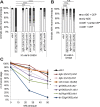6-OHDA-induced dopaminergic neurodegeneration in Caenorhabditis elegans is promoted by the engulfment pathway and inhibited by the transthyretin-related protein TTR-33
- PMID: 29346382
- PMCID: PMC5773127
- DOI: 10.1371/journal.pgen.1007125
6-OHDA-induced dopaminergic neurodegeneration in Caenorhabditis elegans is promoted by the engulfment pathway and inhibited by the transthyretin-related protein TTR-33
Abstract
Oxidative stress is linked to many pathological conditions including the loss of dopaminergic neurons in Parkinson's disease. The vast majority of disease cases appear to be caused by a combination of genetic mutations and environmental factors. We screened for genes protecting Caenorhabditis elegans dopaminergic neurons from oxidative stress induced by the neurotoxin 6-hydroxydopamine (6-OHDA) and identified the transthyretin-related gene ttr-33. The only described C. elegans transthyretin-related protein to date, TTR-52, has been shown to mediate corpse engulfment as well as axon repair. We demonstrate that TTR-52 and TTR-33 have distinct roles. TTR-33 is likely produced in the posterior arcade cells in the head of C. elegans larvae and is predicted to be a secreted protein. TTR-33 protects C. elegans from oxidative stress induced by paraquat or H2O2 at an organismal level. The increased oxidative stress sensitivity of ttr-33 mutants is alleviated by mutations affecting the KGB-1 MAPK kinase pathway, whereas it is enhanced by mutation of the JNK-1 MAPK kinase. Finally, we provide genetic evidence that the C. elegans cell corpse engulfment pathway is required for the degeneration of dopaminergic neurons after exposure to 6-OHDA. In summary, we describe a new neuroprotective mechanism and demonstrate that TTR-33 normally functions to protect dopaminergic neurons from oxidative stress-induced degeneration, potentially by acting as a secreted sensor or scavenger of oxidative stress.
Conflict of interest statement
The authors have declared that no competing interests exist.
Figures








Similar articles
-
Mutations in Caenorhabditis elegans neuroligin-like glit-1, the apoptosis pathway and the calcium chaperone crt-1 increase dopaminergic neurodegeneration after 6-OHDA treatment.PLoS Genet. 2018 Jan 18;14(1):e1007106. doi: 10.1371/journal.pgen.1007106. eCollection 2018 Jan. PLoS Genet. 2018. PMID: 29346364 Free PMC article.
-
Dysregulated LRRK2 signaling in response to endoplasmic reticulum stress leads to dopaminergic neuron degeneration in C. elegans.PLoS One. 2011;6(8):e22354. doi: 10.1371/journal.pone.0022354. Epub 2011 Aug 3. PLoS One. 2011. PMID: 21857923 Free PMC article.
-
Biofilm proficient Bacillus subtilis prevents neurodegeneration in Caenorhabditis elegans Parkinson's disease models via PMK-1/p38 MAPK and SKN-1/Nrf2 signaling.Sci Rep. 2025 Mar 21;15(1):9864. doi: 10.1038/s41598-025-93737-4. Sci Rep. 2025. PMID: 40118903 Free PMC article.
-
Caenorhabditis elegans as an experimental tool for the study of complex neurological diseases: Parkinson's disease, Alzheimer's disease and autism spectrum disorder.Invert Neurosci. 2011 Dec;11(2):73-83. doi: 10.1007/s10158-011-0126-1. Epub 2011 Nov 8. Invert Neurosci. 2011. PMID: 22068627 Review.
-
The Caenorhabditis elegans dopaminergic system: opportunities for insights into dopamine transport and neurodegeneration.Annu Rev Pharmacol Toxicol. 2003;43:521-44. doi: 10.1146/annurev.pharmtox.43.100901.135934. Epub 2002 Jan 10. Annu Rev Pharmacol Toxicol. 2003. PMID: 12415122 Review.
Cited by
-
Assessment of dopaminergic neuron degeneration in a C. elegans model of Parkinson's disease.STAR Protoc. 2022 Mar 31;3(2):101264. doi: 10.1016/j.xpro.2022.101264. eCollection 2022 Jun 17. STAR Protoc. 2022. PMID: 35403008 Free PMC article.
-
Morphological hallmarks of dopaminergic neurodegeneration are associated with altered neuron function in Caenorhabditis elegans.Neurotoxicology. 2024 Jan;100:100-106. doi: 10.1016/j.neuro.2023.12.005. Epub 2023 Dec 8. Neurotoxicology. 2024. PMID: 38070655 Free PMC article.
-
Unraveling Molecular Targets for Neurodegenerative Diseases Through Caenorhabditis elegans Models.Int J Mol Sci. 2025 Mar 26;26(7):3030. doi: 10.3390/ijms26073030. Int J Mol Sci. 2025. PMID: 40243699 Free PMC article. Review.
-
Amyloid β induces hormetic-like effects through major stress pathways in a C. elegans model of Alzheimer's Disease.PLoS One. 2025 Apr 24;20(4):e0315810. doi: 10.1371/journal.pone.0315810. eCollection 2025. PLoS One. 2025. PMID: 40273133 Free PMC article.
-
Infections of Cryptococcus species induce degeneration of dopaminergic neurons and accumulation of α-Synuclein in Caenorhabditis elegans.Front Cell Infect Microbiol. 2022 Oct 26;12:1039336. doi: 10.3389/fcimb.2022.1039336. eCollection 2022. Front Cell Infect Microbiol. 2022. PMID: 36389163 Free PMC article.
References
-
- Sies H, Berndt C, Jones DP. Oxidative stress. Annu Rev Biochem. 2017; doi: 10.1016/j.bpobgyn.2010.10.016 - DOI - PubMed
-
- Delamarre A, Meissner WG. Epidemiology, environmental risk factors and genetics of Parkinson’s disease. Presse Med. Elsevier Masson SAS; 2017;46: 175–181. doi: 10.1016/j.lpm.2017.01.001 - DOI - PubMed
-
- Klein C, Westenberger A. Genetics of Parkinson’s disease. Cold Spring Harb Perspect Med. 2012;2: a008888 doi: 10.1101/cshperspect.a008888 - DOI - PMC - PubMed
-
- Thomas B, Beal MF. Parkinson’s disease. Hum Mol Genet. 2007;16: 183–194. doi: 10.1093/hmg/ddm159 - DOI - PubMed
-
- Nass R, Miller DM, Blakely RD. C. elegans: A novel pharmacogenetic model to study Parkinson’s disease. Park Relat Disord. 2001;7: 185–191. doi: 10.1016/S1353-8020(00)00056-0 - DOI - PubMed
Publication types
MeSH terms
Substances
Grants and funding
LinkOut - more resources
Full Text Sources
Other Literature Sources
Research Materials
Miscellaneous

